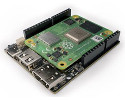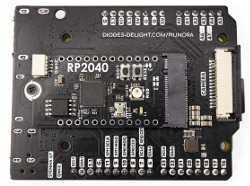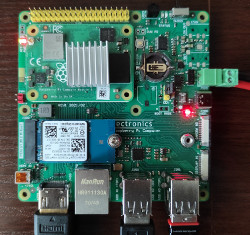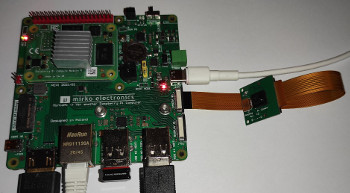Open-spec Piunora and MirkoPC carriers for RPi CM4 feature M.2 for NVMe
Mar 30, 2021 — by Eric Brown 5,310 views Diodes Delight has launched a $39 “Piunora” carrier for the Raspberry Pi CM4 with Arduino, ADC, and Qwiic expansion, and Mirko Electronics is prepping a “MirkoPC” carrier with dual HDMI and a DAC.
Diodes Delight has launched a $39 “Piunora” carrier for the Raspberry Pi CM4 with Arduino, ADC, and Qwiic expansion, and Mirko Electronics is prepping a “MirkoPC” carrier with dual HDMI and a DAC.
Lately, it seems, most of the interesting embedded Linux news has been about carrier boards for the Raspberry Pi Compute Module 4. This morning we covered DFRobot’s tiny, $30 Compute Module 4 IoT Router Carrier Board Mini with dual GbE ports. Here we look at the Arduino-like Piunora board, which just went live on Crowd Supply, plus an upcoming MirkoPC CM4 carrier board. Jeff Geerling recently dropped a YouTube video that used a Mirko Electronics MirkoPC prototype to demonstrate beta code released by the Raspberry Pi Foundation to enable booting from NVMe (see farther below).


Piunora Pro (left) and MirkoPC
(click images to enlarge)
Both the Piunora and MirkoPC are open source boards equipped with M.2 slots capable of running NVMe modules. The Piunora features an Arduino Uno form factor and Shield compatibility plus 8x ADC and a Qwiic/Stemma QT connector for I2C hacking. The MirkoPC is a larger, more feature-rich board with 4x USB ports, 2x HDMI ports, MIPI-DSI and -CSI, and an audio DAC.
The Raspberry Pi CM4 has the same Broadcom BCM2711 SoC with 4x 1.5GHz Cortex-A72 cores used by the Raspberry Pi 4. The CM4 ships with 2GB to 8GB LPDDR4-3200 RAM and 0GB to 32GB eMMC, with optional WiFi/BT.
— ADVERTISEMENT —
In addition to the usual reasons for preferring a compute module instead of an SBC, including greater flexibility for port selection and placement and a smaller, more adaptable form factor, the CM4 has drawn particular interest for its PCIe Gen2 x1 interface. This is is dedicated to USB 3.0 on the RPi 4 SBC. Some CM4 carriers use the PCIe for M.2, mini-PCIe, or dedicated PCIe interfaces, such as the M.2-equipped Gumstix Raspberry Pi CM4 Development Board. Others use it to drive a second Ethernet port, as is the case with the DFRobot board and new carriers from Seeed and Mcuzone.
Piunora
The Piunora was partially revealed on Hackster.io back in December. We briefly covered the initial details in February in a report on Sourcekit’s PiTray mini carrier that also summarized some other upcoming boards including Wiretrustee’s 4-port SATA Board for Raspberry Pi CM4.

Piunora Pro detail view
(click image to enlarge)
The Piunora is available in a $39 Piunora Pro model and $30 Piunora Lite board that removes the MIPI-CSI and M.2 interfaces. Current orders will ship on June 28. The board was developed by well-known hacker Timonsku, who started a company called Diodes Delight to sell it.
The carrier board has an Arduino UNO R3/Adafruit Metro form factor with 3.3v logic and an expansion interface that supports most Arduino Shields. There is no Ethernet port, but you could use a WiFi/BT version of the CM4 or use the M.2 B-key for a wireless module.
You can also connect the Piunora to a PC via the power- and device-enabled USB Type-C port via USB gadget mode, either through a virtual Ethernet connection or as USB mass-storage device. Thanks to Adafruit Blinka, a compatibility layer for CircuitPython on Linux SBCs, “you can use Piunora just like any other CircuitPython dev board,” says Timonsku.


Rear views of Piunora Pro with (left) and without M.2 module
(click images to enlarge)
The Piunora provides a USB 2.0 host port with a USB mode switch for on-the-fly switching with the Type-C port. The board is further equipped with full-sized HDMI port and a microSD slot for use with CM4 Lite models without eMMC. The slot is available with an optional $10 boot card.
The M.2 B-key socket supports SSDs including NVMe, as well as other M.2 modules such as Google’s Coral Accelerator. You also get a full-sized MIPI-CSI camera connector on the Pro model. There are 3x GPIO pins linked to the CM4 plus 2x user buttons and a user LED.
One unique feature among CM4 carriers is the inclusion of 6x 10-bit ADC input headers plus 2x additional channels broken out onto solder pads. A newly announced feature is a Qwiic/Stemma-QT compatible connector designed for adding I2C sensors using Python.
Timonsku touts the board for its obstruction-free pin headers, which “facilitate the development of expansion boards using cheap, two-layer PCBs — or the mounting of Piunora, up-side down, onto larger PCBs.” Also, since all the I/O is on one side, the development of an enclosure should be easier.
MirkoPC
The MirkoPC is a Hackaday.io project created by a Polish developer known as Mirko who is branding the board under the name Mirko Electronics. This suggests the 100 x 100mm carrier will be sold commercially. However, like the Piunora, it is an open-spec board so anyone can make their own or use it as a springboard for a new creation.


MirkoPC prototype, front and back
(click images to enlarge)
The MirkoPC design appears to be close to completion, as well-known developer, blogger, and Raspberry Pi specialist Jeff Geerling recently received a working prototype that he used to demonstrate a new CM4 capability for booting from NVMe. The Raspberry Pi Foundation recently announced the beta-level NVMe boot procedure, which requires pre-release versions of the bootloader, VideoCore firmware, and kernel. The Pi blog also says you need an M.2 M-key slot, such as found on the MirkoPC rather than the similarly NVMe capable B-key slot used on the Piunora. We imagine that B-key support will emerge soon.
Although NVMe booting has been a hacker wishlist item since the CM4 launched in October, the demo is a bit of a let down in that the boot times Geerling showed are almost identical to eMMC or microSD booting. As reported on Hackaday, however, Geerling does demonstrate how much faster it is to load a web page from NVMe (see video below).
In addition to providing an M.2 M-key slot, the MirkoPC is equipped with a microSD slot and a connector for adding additional eMMC. There is also a GbE port with IEEE1548 support, 4x USB 2.0 ports, and a USB Type-C port for power or device/boot mode. A dedicated 5V terminal block input is also available.

MirkoPC with connected camera
(click image to enlarge)
Notable features include 2x HDMI 2.0 ports with 4K@60Hz support, as well as 2-lane MIPI-DSI and MIPI-CSI interfaces. You even get a “high-quality” audio DAC based on I2S (32-bit/384kHz), and there is a DitectDrive headphone amplifier with 128mW output.
The MirkoPC is further equipped with a 28-pin GPIO connector. It is unclear if the other listed I/O, ranging from UARTs to SPI are part of that or available on individual headers. You also get an RTC with battery, 2x LEDs, fan connector, IR, temperature sensor, buzzer, and power switch.
Further information
The Piunora Pro is available for $39 and the Piunora Lite for $30 plus $8 shipping to the US on Crowd Supply. Current orders will ship June 28. More information may be found on the Piunora Crowd Supply page.
No pricing or availability information was provided for the MirkoPC. More information may be found on the MirkoPC Hackaday page, with updates available on Twitter.

Please comment here...